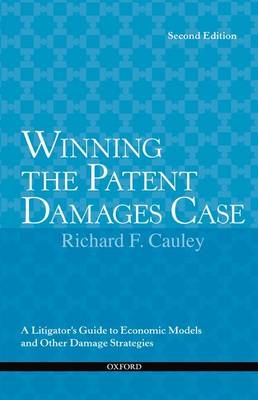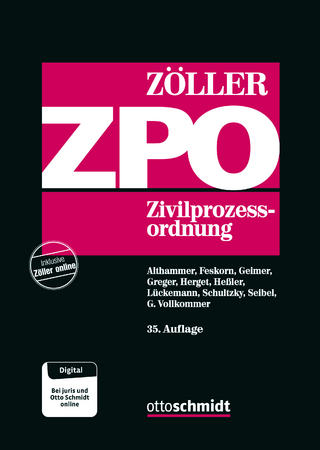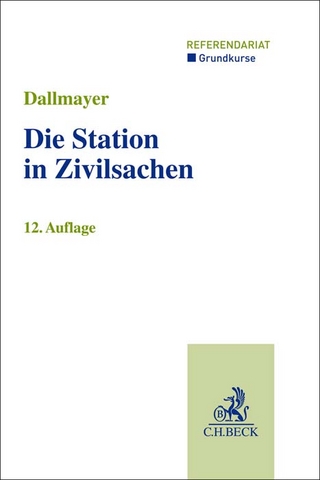
Winning the Patent Damages Case
Oxford University Press Inc (Verlag)
978-0-19-976756-4 (ISBN)
- Titel ist leider vergriffen;
keine Neuauflage - Artikel merken
The discussion centers on the implications of this decision on future damages awards for such patents, how this decision is likely to be used by the courts in the future, and how litigants need to change the way they manage their damages cases to account for this change in the law. Other new developments include whether plaintiffs can use licenses obtained in litigation to prove an "established royalty" under the Georgia-Pacific factor No.1; and courts awarding ongoing royalties instead of imposing injunctions.
The Late Richard F. Cauley is a partner with the Newport Beach, California law firm of Wang, Hartmann, Gibbs & Cauley. Previously, he was a partner with McDermott Will & Emery, LLP, based in Palo Alto, California. He is an experienced trial attorney specializing in complex intellectual property and antitrust matters with particular expertise in matters requiring economic and financial analysis.
SECTION I: Background and Initial Considerations of the Patent Damages Case Chapter 1. Winning the Reasonable Royalty Case 1.01 The Brief Early History of the Reasonable Royalty Remedy [A] The Pre-codified Reasonable Royalty Remedy 1.02 The Modern Era of Reasonable Royalty Begins - Georgia Pacific [A] List of Factors [B] Consideration of Rigorous Economic Analysis Chapter 2: Introducing the Combatants 2.01 The Plaintiff (Types of Plaintiffs-Six Categories) [A] The Dominant Competitor [B] The Minor Competitor [C] Non-Producing Entities (NPEs) [D] Universities [E] Patent Trolls [F] Individuals 2.02 The Defendant Chapter 3. Stranger than Fiction - Imagining the Hypothetical Negotiation 3.01 Applying Game Theory to Hypothetical Negotiation [A] A Zero Sum Game [B] Perfect Exchange of Information [C] You Can't Walk Away [D] Date of Infringement [E] Assumption of Validity 3.02 Determining the Reasonable Royalty Value [A] Game Theory & The Lemney/Shapiro Analysis [B] Injunctions [C] Two More Variables SECTION II: A Strategic Look at the Georgia-Pacific Factors Chapter 4. Finding the Price of the Patent -- Is there an Established Royalty? (Factor 1: The royalties received by the patentee for the licensing of the patent in suit, proving or tending to prove an established royalty) 4.01 Relevance and Application 4.02 Economic Criteria [A] Market Price [B] Time Constraints [C] Example 4.03 The Defendant's Established Royalty Strategy [A] Uniform Royalty/ Licensing Rates [B] Success or Failure of Market Rates? 4.04 The Plaintiff's Established Royalty Strategy -Considerations [A] Number of Licenses [B] Patent-in-Suit [C] Time Period of License [D] Example Case: Monsanto Co v. McFarling [E] Lump Sum & Paid Up Royalties (Example Cases) [F] Effects on Royalty of Widespread Infringement 4.05 Analysis 4.06 Discovery [A] Obtaining Licensing Materials [B] Knowing the Patent's Utility [C] Economic/Market Models [D] Using Your Expert and Attacking Your Opponent's [E] Particular Issues Where Plaintiff Is an NPE Chapter 5: Gauging the Infringer's Price Range -- Licensing-in Practices Factor 2: The rates paid by the licensee for the use of other patents comparable to the patent in suit. 5.01 Relevance and Application 5.02 Analysis [A] Determining the Type of Patented Technology [1] Core Technology [2] Peripheral Technology [B] Is the Patented Technology Essential to the Product? [C] Defendant's Strategy 5.03 Discovery and Using Your Expert (and Attacking Your Opponent's) Chapter 6: Keeping it Exclusive - How Valuable is that License? Factor 3: The nature and scope of the license, as exclusive or non-exclusive; or as restricted or non-restricted in terms of territory or with respect to whom the manufactured product may be sold. 6.01 Relevance and Application 6.02 Analysis [A] Who Makes (and How to Make) the Exclusive License Argument [B] Defendant's Strategy 6.03 Discovery [A] Use Your Economic Experts [B] If the Plaintiff is an NPE Chapter 7: Keeping it to Yourself - the Hypothetical Negotiation Where the Seller Doesn't Want to Sell Factor 4: The licensor's established policy and marketing program to maintain his patent monopoly by not licensing others to use the invention or by granting licenses under special conditions designed to preserve that monopoly. 7.01 Relevance and Application [A] Sample Scenario: Tiny Motors Corp. [B] Establishing Historical Practices 7.02 Analysis 7.03 Discovery and Using Your Experts Chapter 8: Selling Your Enemy the Stick to Beat You With - The Hypothetical Negotiation Where the Plaintiff and Defendant Compete Factor 5: The commercial relationship between the licensor and licensee, such as, whether they are competitors in the same territory in the same line of business; or whether they are inventor and promoter. 8.01 Relevance and Application 8.02 Analysis 8.03 Discovery and Using Your Experts Chapter 9: Boosting the Royalty Rate with Unpatented Products - Mercy Sakes Alive! Looks Like we Got us a Convoy! Factor 6: The effect of selling the patented specialty in promoting sales of other products of the licensee; the existing value of the invention to the licensor as a generator of sales of his non-patented items; and the extent of such derivative or convoyed sales. 9.01 Relevance and Application 9.02 Analysis [A] Plaintiff Considerations [B] Defendant's Perspective 9.03 Discovery and Using Your Experts Chapter 10: How Much Time is left? The Effect of an Expiring Patent Factor 7: The duration of the patent and the term of the license. 10.01 Relevance and Application 10.02 Discovery Chapter 11: Buy my Product - Buy my Patent! How the Success of a Patentholder's Product Can Raise the Royalty Rate Factor 8: The established profitability of the product made under the patent; its commercial success; and its current popularity. 11.01 Relevance and Application 11.02 Discovery Chapter 12: Why New and Improved Costs more than the Old Stuff - The Better Your Invention, the Higher the Royalty Rate Factor 9: The utility and advantages of the patent property over the old modes or devices, if any, that had been used for working out similar results. 12.01 Relevance and Application 12.02 Analysis 12.03 Discovery Chapter 13: The Smaller the Bang, the Smaller the Bucks - Allocating the Value of the Patented Component Factor 10: The portion of the realizable profit that should be credited to the invention as distinguished from non-patented elements, the manufacturing process, business risks, or significant features or improvements added by the infringer 13.01 Relevance and Application 13.02 Analysis 13.03 Discovery SECTION III: WINNING THE LOST PROFITS CASE Chapter 14: The Theory of Lost Profits 14.01 The Panduit Factors 14.02 Competition between the Plaintiff and the Defendant and the Defining Market-The Battle of the Flying Bikes 14.03 Analysis 14.04 Discovery Chapter 15: Market Players 15.01 How Many Players Are in the Market? And Why Does It Matter? 15.02 Analysis Chapter 16: Working the Hypothetical Work-around-Alternative Non-Infringing Substitutes 16.01 Analysis 16.02 Discovery Chapter 17: Lost Profits on Unpatented Products and Components-The Entire Market Value Rule 17.01 Analysis 17.02 Discovery Chapter 18: Recovering Profits Lost by Price Erosion-And Paying Attention to the Demand Curve 18.01 Analysis 18.02 Discovery Table of Cases Index
| Erscheint lt. Verlag | 25.8.2011 |
|---|---|
| Verlagsort | New York |
| Sprache | englisch |
| Maße | 179 x 236 mm |
| Gewicht | 298 g |
| Themenwelt | Recht / Steuern ► EU / Internationales Recht |
| Recht / Steuern ► Privatrecht / Bürgerliches Recht ► Zivilverfahrensrecht | |
| Recht / Steuern ► Wirtschaftsrecht ► Urheberrecht | |
| ISBN-10 | 0-19-976756-4 / 0199767564 |
| ISBN-13 | 978-0-19-976756-4 / 9780199767564 |
| Zustand | Neuware |
| Haben Sie eine Frage zum Produkt? |
aus dem Bereich


